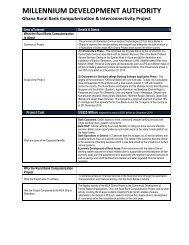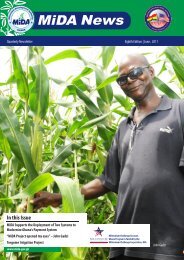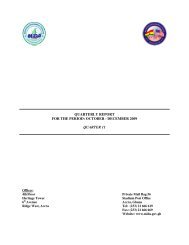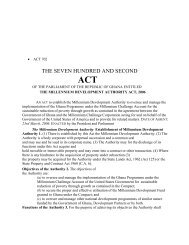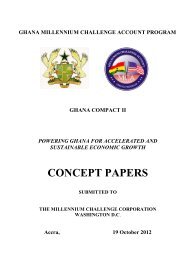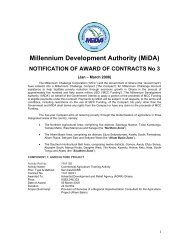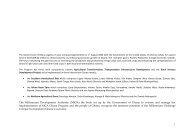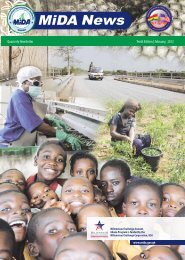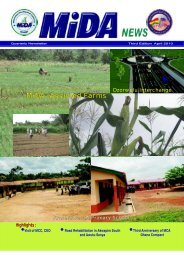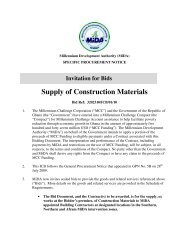Download full document - MiDA Ghana
Download full document - MiDA Ghana
Download full document - MiDA Ghana
You also want an ePaper? Increase the reach of your titles
YUMPU automatically turns print PDFs into web optimized ePapers that Google loves.
Upgrading of N1 Highway Between Tetteh Quarshie Interchange and Mallam Road Junction, Accra, <strong>Ghana</strong>.Resettlement Action Plan (RAP), Lot 24.2.5 Parking Areas for Public TransportSix (6) parking areas used by 4 main transport unions were identified on the corridor.The services of these transport unions will be affected since they need alternative areasto park, pick and drop passengers. The 4 transport unions have a total membership ofabout 975 2 ; made up of drivers and their apprentices. These transport unions include<strong>Ghana</strong> Private Road Transport Union (GPRTU), the Progressive Transport OwnersAssociation (PROTOA), Co-Operative Transport Union and the Water TankersAssociation. Two parking areasare located at Abeka-Lapaz within the 74 meter widthROW. The remaining 4 parking areascan be found within the 82 meter ROW at Awoshie,Kwashieman, and Mallam.4.3 AGE AND SEX DISTRIBUTIONThe age distribution of the population in the communities along the corridor mirrors thegeneral trend of the age distribution of population in <strong>Ghana</strong>. The communities have ayouthful population between the ages 18 and 42 years old. Majority (4,300) of the PAPswere between 18-42 years old. Older respondents aged 65 years and above were onlyfew. This means that most PAPs were in their reproductive years. Most males andfemales were aged between 18 and 42 years.4.4 EDUCATIONAL ATTAINMENTA greater proportion (4,404) of the PAPs had formal education. Basic education whichended at Junior High School (JHS) or Middle School Leaving Certificate (MSLC) accountedfor more than three-quarters of the total respondents. Majority of males and only asmall percentage of female respondents were JHS leavers while the reverse is true forSenior high School (SHS) or Secondary education respondents. Male and femalerespondents with only Primary and Koranic education constituted a tiny minority.Respondents with tertiary education were very few; with male respondents being morerepresented in this category than females. When disaggregated by gender, the totalfemale respondents with formal education were slightly higher than the males.4.5 NATIONALITY AND ETHNICITYA vast majority (5,514) of the respondents of these communities were <strong>Ghana</strong>ians. OtherECOWAS nationals made up the remaining percentage. Majority of the <strong>Ghana</strong>ianrespondents were Akans who constituted more than half of the total respondents.Ewes made up the next largest ethnic group, while Ga/Adangmes formed the thirdlargest group. The rest were people from other ethnic groups in the three northern2 These members were not enumerated individually and are therefore not part of the 5,579 PAPsindicated. Only their unions were counted.31



